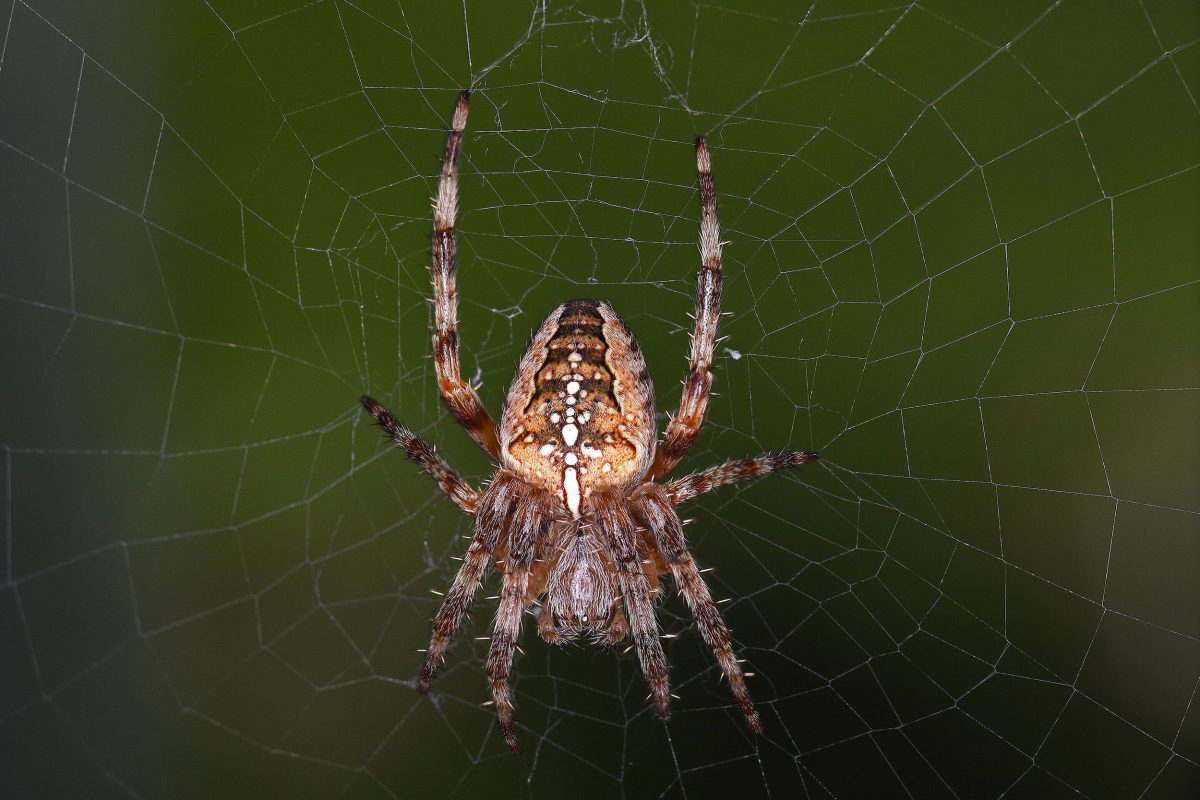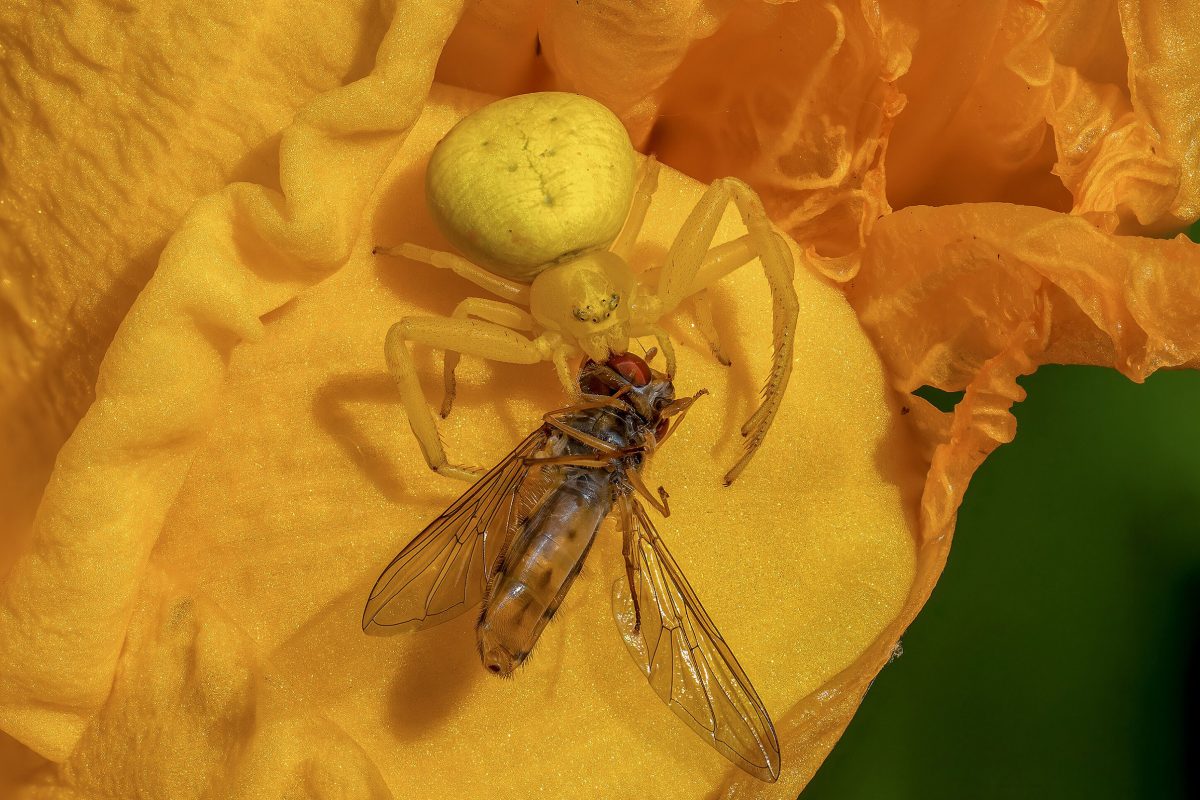The grey skies and showers today make me realise that summer is coming to an end. Which means we can find more spiders.
The fact that spiders are more noticeable in the autumn may explain their enduring presence as a symbol of Halloween. But why do we see them more at this time of year? There are several reasons.
First, they are bigger. The ones about to breed have grown to their maximum size by the autumn. Second, they want to be visible; this is mating season and they need a partner. And third, autumn is the season of frost and dew (more dew than frost in London these days), which adorn and make more visible their splendid webs on a cold morning. If you walk down the Nature Trail on a still autumn morning, you will find webs glistening in the grass and suspended in the gaps between bushes. Who is making all these webs?
There are 670 species of spider in the UK. About half of these species are tiny ‘money spiders’ (who are incredibly abundant in grassland habitats, with as many as two million of them per acre) but almost impossible to tell apart to the causal spotter.
Thankfully there are a few we can identify more easily.
Garden cross spiders
Probably the most conspicuous spider on the Nature Trail is the garden cross spider (Araneus diadematus), which belongs to the family of orb web spiders or ‘orbweavers’, referring to their circular, classic looking webs.

The garden cross spider is one many of us can identify. They have a bulbous abdomen, decorated with a cross of pale spots, which is often very clear (although sometimes rather faint). They can be sandy brown, orange, or even black.
This is the spider of our childhood gardens and parks.
Most of us will have got our face mixed up in their webs on a summer morning. It happens because they build webs across insect flyways: clear spaces between foliage where we (as well as the insects) might choose to move along. Spiders may also spin their webs near a light source which will attract their potential insect prey.
We often see garden cross spiders sitting on their web, waiting. Once a hapless insect has flown into their web, the spider is alerted by the vibrations of its struggle. It jolts to life, scuttles over, kills the prey with a bite of their poisonous fangs and wraps it in a silk cocoon to enjoy later. In the evening, the cocoons, and the day’s web, along with any smaller insects trapped in it, are all gobbled up. Valuable proteins cannot be wasted!
Each spider eats up to 500 small insects every day. Globally, spiders eat a greater mass of insects than birds do.
The spider will spin a new web that night or in the early morning, ready for the next day, using the strong thread produced from their silk glands (the visible portion of which is known as the spinneret) in their abdomen. The threads are incredibly thin; a whole web can be scrunched up into a tiny parcel the size of a grain of rice.
Sexual cannibalism
Spiders mate in the autumn.
The garden cross spider is one of those species where the female will eat the much smaller male after mating if he is not quick enough in getting away. This ‘sexual cannibalism’ doesn’t occur in all spider species, and there are species described where males are the cannibals, attacking and eating older females and then mating with the younger ones!
Very recently, Chinese researchers have uncovered an interesting male behaviour to avoid becoming their partner’s dinner after sex. Immediately after mating, the male Philopenella prominens spider efficiently catapults himself off the female’s body at enormous speed – spinning 75 times per second – using specially adapted ‘hydraulic’ front legs. Males who don’t do this will just get eaten.
The function of sexual cannibalism in spiders, as well as being fascinatingly gruesome, is much debated; there may be several reasons why it happens.
In part, it may be that males are designed to die soon after mating, so the female might as well get some calories from his body to nourish her new eggs. This will be of benefit to her, but also to the genes of the male, as a healthy well-nourished female carrying his genes in her eggs is more likely to lay and look after those eggs effectively. This may be why (in some species) the male spider appears to not even try to escape his grisly fate.
The story though, as the Chinese research hints at, is likely to be different for different species. In the case of the Philopenella spider some males are clearly not at all ready to die after their sexual encounter, and catapult themselves off their mate to find another female.
Stars of Urban Legends
Back to the Nature Trail. Our female garden cross spider needs to be tough.
She lays her eggs in a specially constructed silk sac, and then stays with her children to protect them until she dies in late autumn. In May, the spiderlings emerge, yellow and black, and tiny. They stick together in a bunch unless they are disturbed, when they scatter and scarper to evade being eaten, only to return together once danger has passed. It takes two years for them to mature into adulthood, and then the cycle starts again.
You may have heard the strangely persistent urban legend about the woman who goes on holiday to somewhere hot, returns with a painful swelling on her face which bursts, releasing hundreds of baby spiders. I can remember our English teacher telling our class exactly this story in 1976! We all loved the story, but a story is all it is.
According to Snopes, a likely antecedent to this legend is a story written in 1842 by the Swiss novelist Jeremias Gotthelf called Die Schwarze Spinne (The Black Spider) in which a woman makes a pact with the Devil, sealed by his kiss on her cheek. When the Devil is cheated by villagers, a black boil begins to grow on the spot where he kissed her, which eventually bursts releasing venomous spiders!
There are some insects and worms that infect human skin, but spiders do not.
Spiders can bite humans, but the bite of British spiders rarely penetrates far. Although I have to say, in the interest of being balanced, I was once bitten by a house spider (I think) which had found its way into my bed, and objected to me trying to brush it off my face in my half-asleep state. The bite was painful enough to wake me up, but not as painful as a wasp sting.
There’s a good article from the Natural History Museum on the different types of web and the spiders who make them. The little money spiders make sheet webs, large thin masses of web, in the grass. The house spiders (the ones that you find in the bath and run across the living room too fast (according to my wife), make funnel webs.
Other spiders on the Nature Trail
One of the other conspicuous web-makers of the Nature Trail is the nursery web spider (Pisaura mirabilis) whose web is built not to catch prey but to protect its young. They can often be found sunbathing on a leaf of bramble or nettle, resting in a characteristic posture with their two front pairs of legs lying very close together, as this photo of one I found on the Nature Trail shows.

Nursery web spider. Image: Daniel Harwood
This fast and ruthless hunter of flies and other insects does not need a web to catch prey. The web is a protective nursery for the spiderlings. The female carries her large egg sac in her fangs, but before the eggs hatch, she spins a tent-like web into which she places her children.
Here’s another spider resident of the trail, the crab spider (Xysticus spp).

Crab spider on the Nature Trail. Image: Daniel Harwood
Crab spiders have a squat, dumpy body and quite often walk sideways as their name suggests. Being ambush hunters, they do not spin webs.
One species, that I have not yet seen on the Nature Trail is the flower crab spider (Misumena vatia), who sits inside flowers ready to ambush unsuspecting pollinating insects who land on the bloom. Chameleon-like, the females of this species even change colour according to the shade of the flower it is sitting in!

Spiders are a fascinating group of animals. This autumn, please have a closer look at those webs and the spiders who made them.
They are not as scary as we have been led to believe…

The Black Spider by Franz Karl Basler-Kopp, Museum of Art Lucerne, Switzerland


